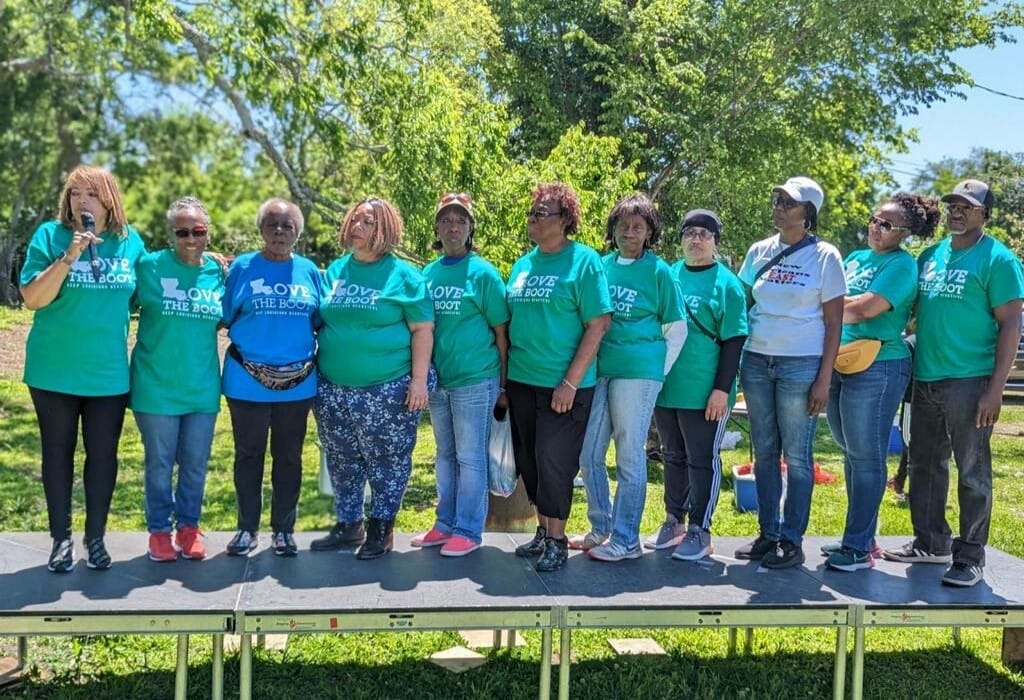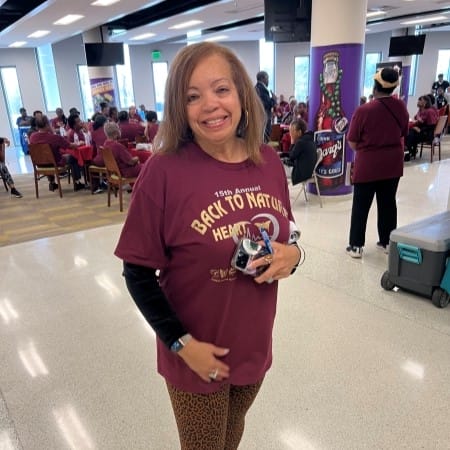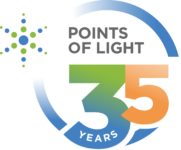Renewal and Community at a Beloved Park in New Orleans East

Meet Daily Point of Light Award honoree Tangee Wall. Read her story, and nominate an outstanding volunteer or family as a Daily Point of Light.
For more than 16 years, Tangee Wall has been a constant and powerful advocate for New Orleans East. As president of both New Orleans East Matters and Friends of Joe W. Brown Park, she has dedicated over 120 volunteer hours each month toward revitalizing the area she’s called home for 35 years. From hosting community information sessions to leading beautification efforts and organizing local markets and cultural celebrations, Wall has remained unwavering in her mission to create a thriving future for her neighborhood.
One of Wall’s most persistent causes has been the redevelopment of the long-abandoned Six Flags site. For over a decade, she has advocated for a visionary project to replace the blight with meaningful development, and now, that persistence is paying off as the Bayou Phoenix project moves forward. In every public meeting and community update, Wall emphasizes the need for community-led planning and sustainable economic growth. Her goal has always been clear: to ensure New Orleans East receives the same investment and attention as other parts of the city.
Wall also sees public safety as intricately tied to opportunity and youth engagement. She firmly believes that continued engagement and activities for youth help curb crime, and she’s backed up that belief with action—hosting regular events that provide safe spaces for young people and bringing partners together to support crime prevention strategies through community involvement.
Whether advocating for strategic billboard placements to boost local messaging or planning health events and cultural festivals, Tangee Wall’s volunteerism is rooted in action, passion and deep love for her community. Her work is not just about rebuilding infrastructure—it’s about restoring dignity and pride to New Orleans East. Read on to hear more of her story.
What inspired you to get started with this initiative?
It began about 16 years ago, post Hurricane Katrina. My family moved to Baton Rouge for a limited period of time. I worked here at the University of New Orleans at the time, and the campus had been devastated by the storm. It was all just a complete change of everything, overnight, with Hurricane Katrina. In coming back to New Orleans – and specifically to the part of the city I live in, New Orleans East – after such devastation and seeing our neighborhoods, our homes, the churches, the schools. You just can’t imagine how that looked upon first coming back to the city.

I was very fortunate to have homeowners and flood insurance, so my journey wasn’t as difficult with our personal home. But with the community, I just felt compelled to help. So many of our neighbors, friends and colleagues were in the same boat. I met Chris with HandsOn New Orleans. Organizations like that are just lifesavers. They equip volunteers from all over the country. We developed a great relationship, with his interest in trying to help us put our neighborhoods and our infrastructure back.
This became a mission of mine, as well as some colleagues and neighbors who were planning to come back. Many people were so frustrated, so devastated that they decided not to come back. For those of us who felt like there was hope in trying to rebuild, we formed the Friends of Joe W. Brown Park. We saw the park as a center of family life, as a beacon of hope to bring back to the community. Not just our homes, but beyond that, having a place again, something to look forward to. The desire for home really compelled the drive to do these things. And HandsOn New Orleans really helped with outreach.
Why is this issue so important to you?
The park had been meaningful. Joe W. Brown Park is a regional park, 125 acres of beautiful natural environment. We had seen that trees were destroyed, the brush, the wetlands, part of the nature center. Louisiana Nature Center had been very important too. The natural environment is what this part of the city is truly known for. The bird sanctuary. The different species of trees and insects. The flora and the fauna. We wanted it all back. Not just our houses, which are part of our homes, but the home that also included our community.
Tell us about your volunteer role.
I’ve helped build from ground zero, from the bottom up. We formed a 501(c)(3) nonprofit. The park is what I’m centrally focused on. The park opened up a world of opportunity to our entire community as a safe space, a place to recreate. There was nothing else to look to in terms of socializing or recreational benefits. The park became a mission.
Once we formed the organization, more and more people joined. We had frequent cleanups and beautification projects, with the help of HandsOn New Orleans and a couple of others. Pretty soon, we had the city involved to redo the surfaces of the park and bring back athletics. Our public-private partnerships were very helpful to us. Audubon was very helpful to us with the Nature Center. We started to be able to provide a place where the youth could actually form their athletic teams again, for the schools to enjoy again.
It’s a major task. Joe W. Brown Park is a sizable environment. Believe it or not, we’re still in the mode of clean up. Of course, there’s also continuous beautification. I’m so proud of all of these individuals who came together. We were the foundation in bringing the hope back in expanding these partnerships. No one was afraid to work, to go to the city, speak up on behalf of what the needs were and are.
During the pandemic, the park was essential as an open-air environment. We had opened up an environment that many people didn’t know existed. There was an awakening, and we reached out-of-state folks. We had a lot of help. These volunteers were very taken with our resilience. It was so worth it to do ourselves, as a total grassroots effort. We eventually, after a few years, received grants, support, sponsors, donors. And that was from the cry of the grassroots efforts, seeing people put their hands in the dirt and shovels in the grounds.
We made new friends and new neighbors, opening to new people and the kindness of strangers. We didn’t know a lot of these people from far away, as far as California, Georgia, Boston, Texas. These people understood the devastation of a hurricane, and they understood that if you’re fortunate enough to have your life, you know you need to rebuild.
Tell us about the carousel.
Always children at heart, our goal was to have a carousel. I remember as a kid, going to Lincoln Beach, which is also under redevelopment, and riding the carousel. So the goal is to bring back the jewels and the assets of our community. About two years ago, some folks from New York and California were doing some work in the park. We began a conversation. ‘How high was the water?’ ‘Which areas were affected?’ We told the story over and over to people. This particular team was doing some work in the front entrance of the park. I told them that our lifelong goal was to have a carousel. We were the only regional park and only area of the city that had so much devastation without bringing back something transformative, something from the past.
Just recently, we received a grant that will allow us to have the installation of our carousel. It’s going to be history-making. It’s going to be brand new. And we’re hoping to have it completed by the end of the year, in time for Christmas, which was always so special at the carousel.
What’s been the most rewarding part of your work?
The biggest positive blessing has been new friends. We mourn the loss of others, and we remember them. This year is so vital. It’s our 20th anniversary. There will be lots of activity, as well as memorializing. The kindness, truly, of strangers who had never met us, and those who are our neighbors. We’ve all embraced it. We feel very blessed and fortunate that we had help from all over.
Why is it important for others to get involved with causes they care about?
Direct contact is always felt. We believe in the personal touch. There is nothing that replaces it. Chris has been such a great leader, one who encourages boots on the ground. There’s nothing like a grassroots movement. Not only does it produce high-quality work, but it produces a certain camaraderie. It brings people together from very diverse backgrounds. Politics doesn’t matter. Race, ethnicity, gender, sexual orientation… you don’t see or recognize any of that when an entire community is in need, an entire city is devastated. People naturally come and embrace. We’re hospitable here. And to be shown that by others, seeing the hospitality that others brought, it lets you know that human nature is a good thing.
Any advice for people who want to start volunteering?
My advice is to reach out and get involved. If you’re in a neighborhood, find out if there are neighborhood meetings. Some of our young people weren’t even born when Katrina hit. We have to teach them. We open up volunteer opportunities to the schools. Just get involved. Take every opportunity you can to just get involved.
Do you want to make a difference in your community like Tangee? Find local volunteer opportunities.
